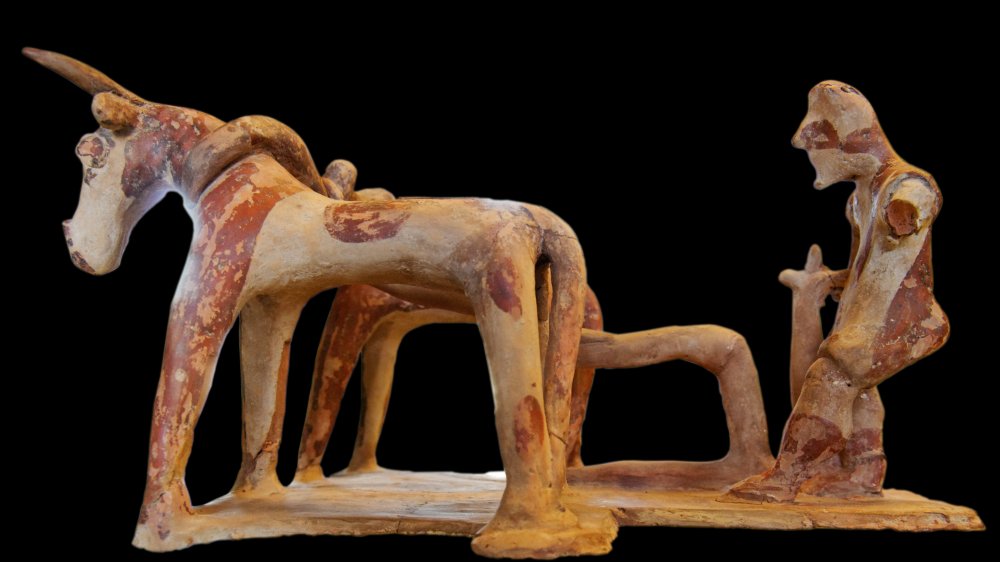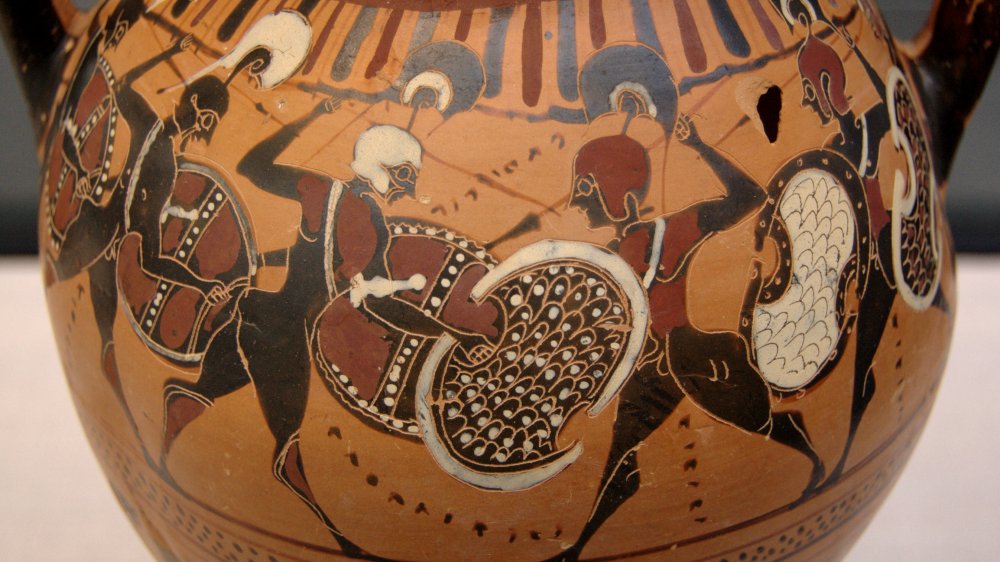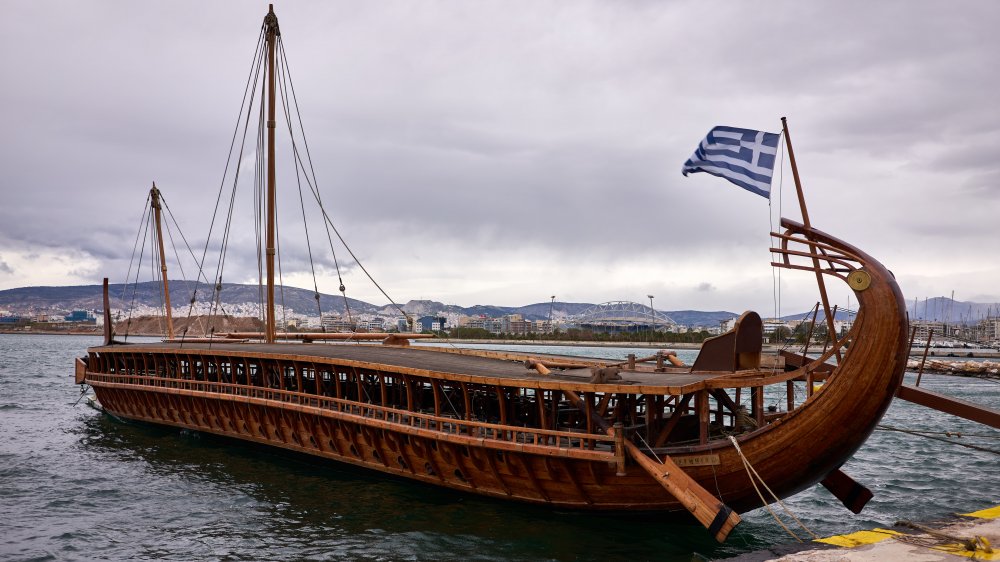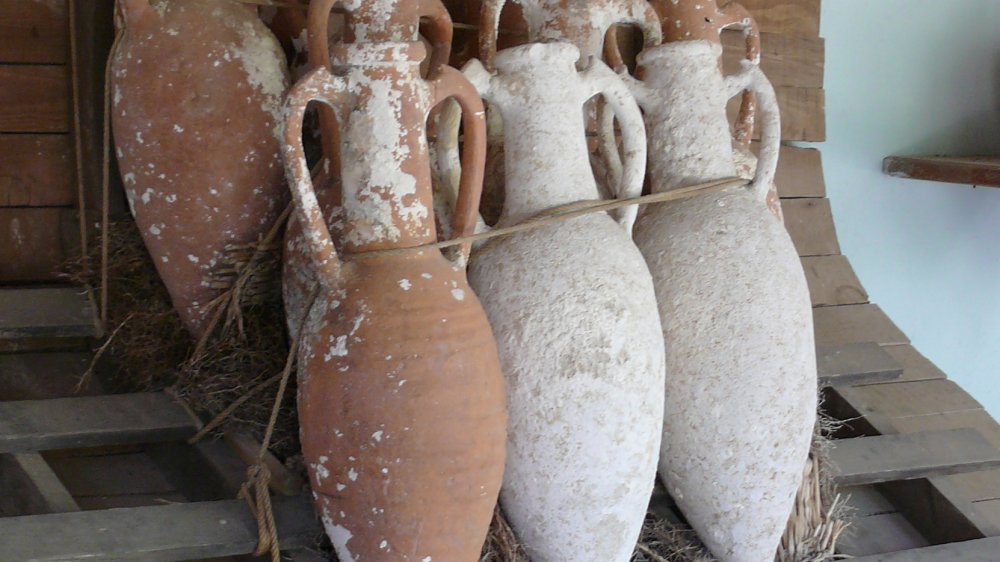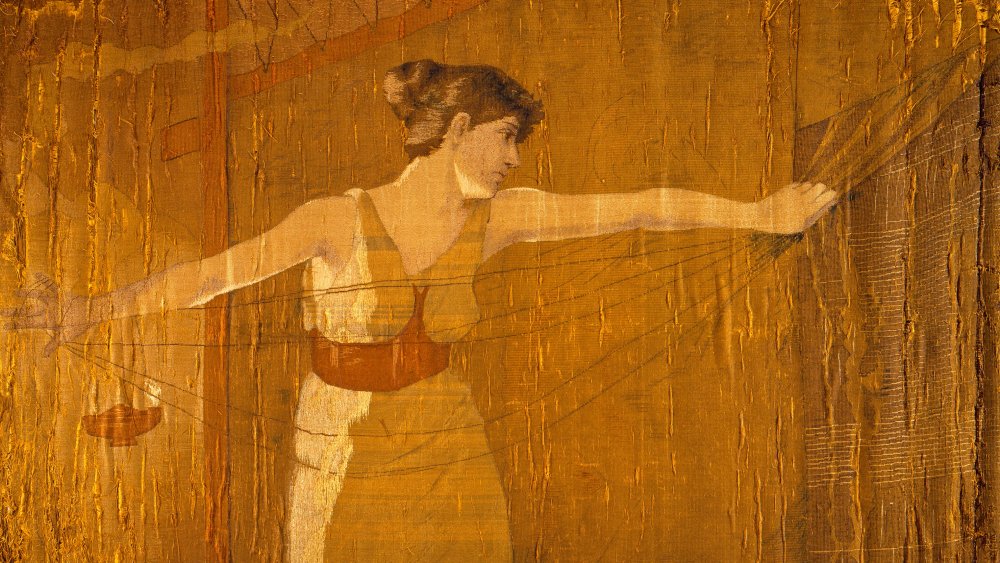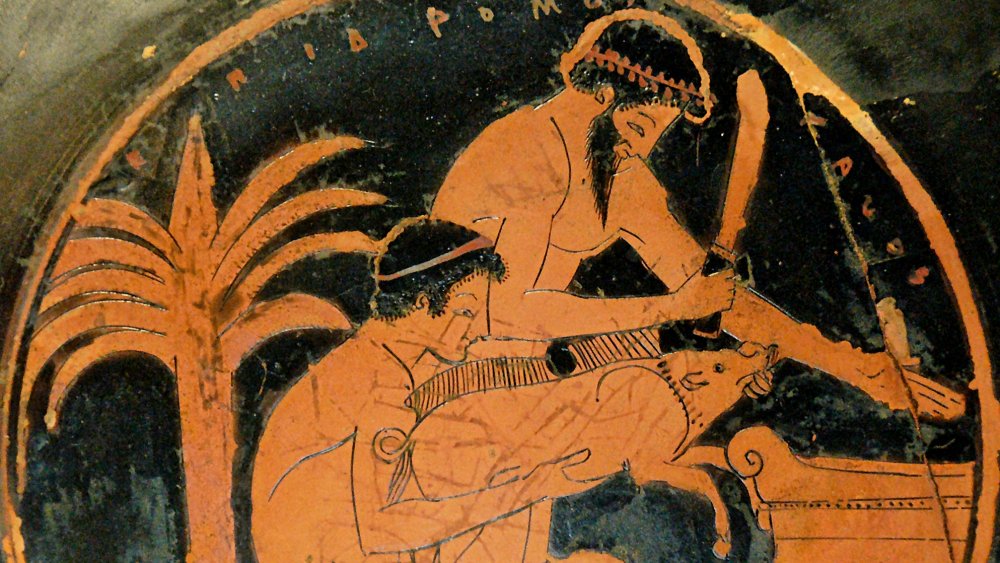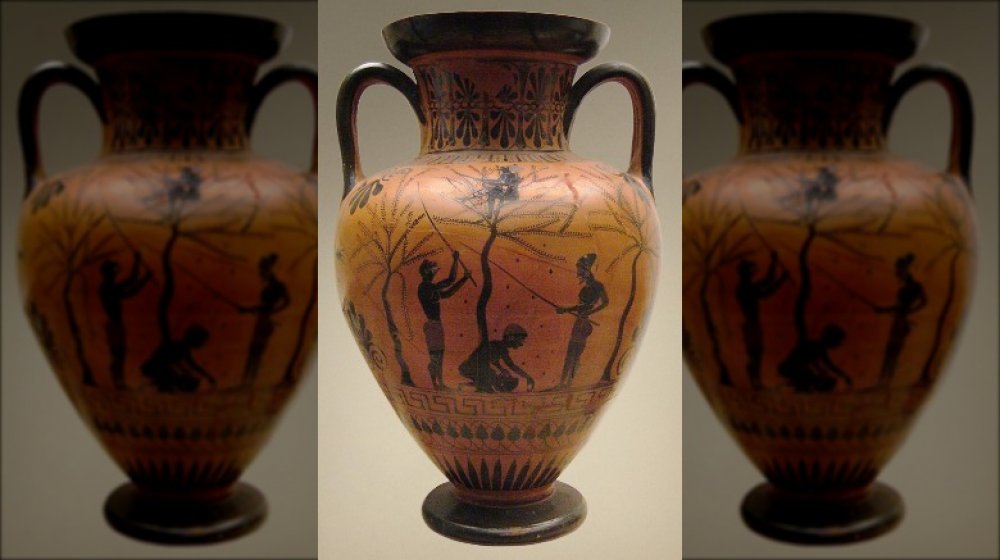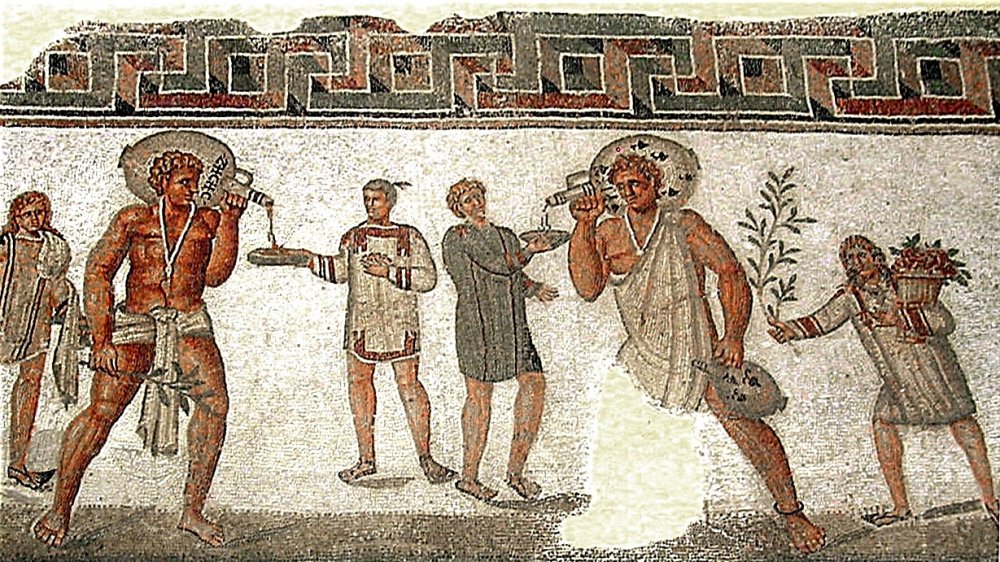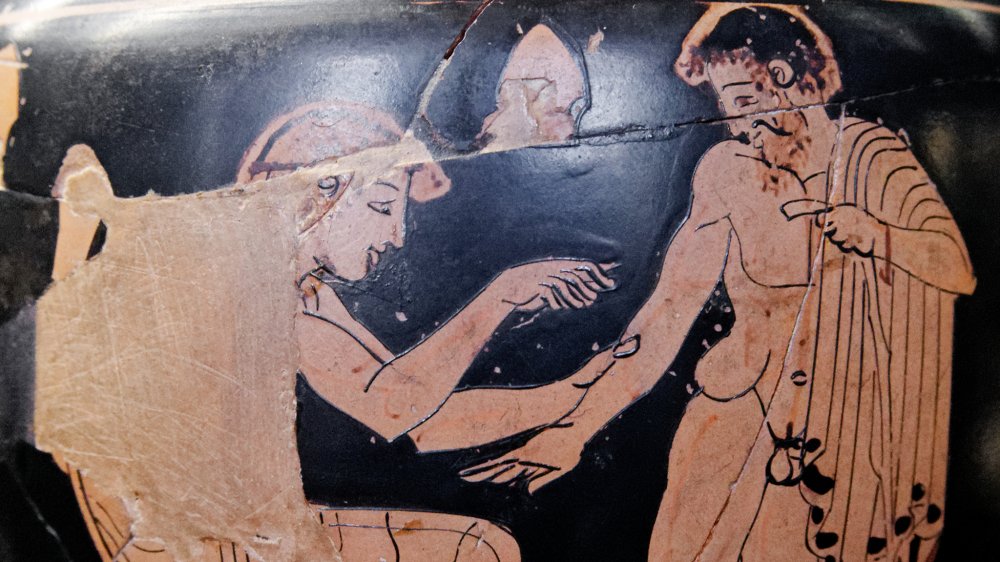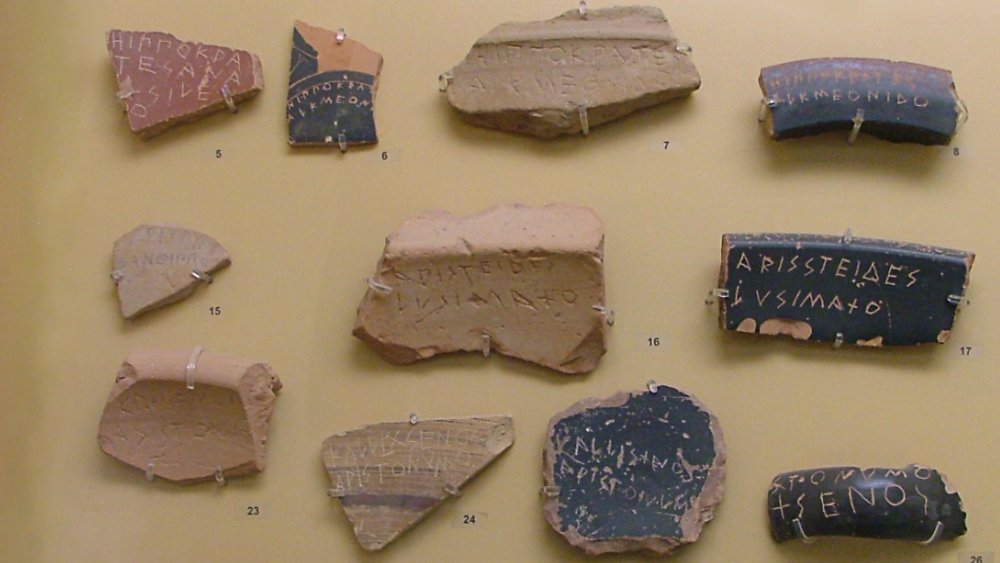Things The Ancient Greeks Couldn't Live Without
The ancient Greeks — the culture of Homer, Socrates, Aristotle, and Archimedes, among many notable others — gave the world many significant advancements that we still use in daily modern life: theater, cranes, geometry, the Olympics, advances in astronomy and philosophy and medicine, and so on. There's even a rumor that democracy is still happening somewhere in the world today. But if these are the things of Greek origin in our daily life, what are the things that an ancient Greek couldn't live without?
Keeping in mind that Greek culture could vary a lot from city to city (the Athenians and the Spartans famously clashed over fundamental cultural concepts), there are certain things that were universal to the ancient Greek experience. From cooking food to making clothes and building homes, from going to war to going to the bathroom, here are the day-to-day items without which the ancient Greek world might just have fallen apart.
Old Themistocles had a farm, epsilon-iota-epsilon-iota-omicron
Farming was essential to the Greek way of life, not only for meeting the bare necessities of survival but because the ability to grow and store food is what made Greek culture possible. There's no time to work on philosophy or poetry or architecture if you're worried about where your next meal is coming from. As the Ancient History Encyclopedia explains, the types of crops most suited to Greece's Mediterranean climate were grapes, olives, and grains such as wheat and barley. Being a rocky seaside country means that only about 20 percent of Greek land is arable, so it was absolutely necessary to make the best use of what was available to maximize output. As such, the development of agricultural techniques and tools was very important for Greek society.
The primary farming tools in ancient Greece were plows, hoes, and mattocks (kind of a mix between a hoe and a pickax) either made out of wood or tipped with iron. The spade, commonly used for digging in other cultures, did not exist in ancient Greece. Sickles were used for harvesting, and a flat shovel was used for winnowing grain (separating the heavier, edible parts from the lighter, inedible parts). If you were rich enough to afford livestock, oxen could make plowing fields and threshing grain much easier.
My big fat Greek warfare
Warfare was a daily reality in the ancient Greek world, ranging from border skirmishes between neighboring city-states to major civil wars to giant multistate alliances against foreign powers. As a result, citizens might be called on to supplement professional state forces at any time, though military strength and rigor varied widely from city to city and across time. The standard Greek soldier was the infantryman known as the hoplite, and as Hellenic Art explains, while the equipment of a hoplite was far from standardized, there are certain commonalities you could expect.
The most important piece of equipment was the large, round shield known as the aspis, or hoplon (from which the word "hoplite" derives), which was made of wood covered in bronze and protected the hoplite from chin to knee. Its heavy weight and high mobility made it useful as an offensive weapon as well as a defensive one. The main offensive weapon was a spear called a dory, which was 7-9 feet long with a curved, leaf-shaped tip. The secondary weapon was a short sword called a xiphos, which was used when the dory was broken or lost. Wealthy soldiers might have a bronze breastplate and helmet, while peasant soldiers might have no armor at all behind their shields. In between, the most common armor was reinforced linen fabrics called linothorax.
Greek woodwork makes the Greeks' good work
If you remember learning the difference between Doric, Ionic, and Corinthian columns in school, then you may have an idea of how important architecture was to the ancient Greeks. While many of their most famous buildings were rebuilt in stone, woodworking was an essential skill in developing Greece into the hub of Western civilization that it would become. Besides being at the heart of building homes and temples, woodwork and carpentry were necessary for the construction of chariots and the ships that made the Greeks so successful in warfare.
According to Alter Eagle's History of Carpentry, the master carpenters of ancient Greece were known as arhitektons (the source of the English word "architect"), and this title could be equally applied to the shipbuilders who made Greek triremes (warships with three banks of oars), master builders of temples, and any kind of woodworker. The more common carpenter, known as a tekton, would have likely been a freedman or often a slave. The basic tools of a Greek carpenter would have been made first of bronze and then later of iron and would include files, planes, hammers, axes, drills, rasps, augers, chisels, and adzes. The Greeks were also responsible for the development of more advanced construction tools as well, including pulleys, levers, pumps, cranes, winches, gears, and the Archimedes screw, a device for raising water.
Ancient Greece was like one big Pottery Barn
Anyone who visits the Greek section of a history or art museum has doubtlessly seen examples of ancient Greek ceramics and pottery. Clay pots, though easily shattered, are relatively durable and, as such, are very common artifacts for archaeologists to find. Additionally, the highly decorated black-figure and red-figure pots so heavily associated with Greek culture have been significant contributors to our understanding of their day-to-day culture, religious practices, and mythological beliefs.
However, as the Ancient History Encyclopedia points out, as beautiful as these pots can be as cultural representation and objets d'art, they were intended for everyday use. The massive two-handled jars known as amphorae were often used for storing large amounts of wine, water, oil, or perfume. Other everyday ceramic containers included mixing bowls called kraters, wine-pouring jugs called oinochoai, stemmed drinking cups called kylixes, water jars called hydras, and more.
Potters would make these vessels from clay on pottery wheels. The pots would then be decorated with a thin, black paint made of a mixture of potash, clay, and black ferrous oxide. The paint was made to adhere to the ceramic with a fixative, often made of urine. But don't worry if you've been licking ancient pots: The urine would burn away in the kiln.
Weaving was basically the one thing Greek women were allowed to do
Although the role of women in ancient Greece could vary from one city-state to another, generally speaking, there wasn't a lot they could, like, do. By and large, they couldn't vote, they couldn't own land, and they couldn't inherit property (the women of Sparta being a notable exception). What they could do was have children, raise children, and ... weave. Weaving was a highly prized skill among Greek women, and not just because it kept them out of sight, where men liked them. Weaving and other woolwork is how most clothes and other fabrics were made, and among the Mycenaeans, textiles were a significant export. Mythological figures such as the goddess Athena and Odysseus' wife Penelope are revered in legend for their great skill at the loom.
According to The Role of Women in the Art of Ancient Greece, the looms used by Greek women featured an upright frame attached to the wall. This frame had a roll at the top where the women, who worked standing in front of the looms, could wind up their finished work. The warp (the vertical threads being woven) would be weighed down with small clay weights, and all weaving was done by hand. The Greeks didn't have spinning wheels to turn wool into thread but instead used handheld spindles and distaffs, pulling the wool, which had been prepared on a rough clay device called an epinetron, from a basket.
The ancient Greeks did wear clothes, just not a lot of them
While the impression many modern people might have about the ancient Greeks based on their best-known pieces of art is that they were just naked all the time, the Greeks did, in fact, wear clothes (sometimes). Their clothing was usually very simple, made of as few pieces of cloth as possible, and definitely worn for function and not fashion. Mediterranean summers can be incredibly hot, so when it came to Greek couture, less was definitely more.
As the Ancient History Encyclopedia explains, most Greek clothing was made of either wool fabric woven at home or imported linen fabrics. While babies went completely naked, pretty much everyone else wore clothes made of a single rectangle of fabric held together by pins. The typical outfit for a man was a short linen tunic called a chiton, which was worn draped over one or both shoulders. In winter or other cold weather, they would wear a heavy wool cloak called a himation over their tunic, which could double as a nice, warm blanket for soldiers or travelers. Women generally wore a long wool tunic called a peplos or peplum (a style still popular today, after a fashion), which would be fastened with pins or brooches. Greeks also had various styles of hats but almost never wore shoes. Note that absolutely none of these things are called a toga, which is a specific Roman clothing item.
Making dinner the ancient Greek way
Many of the elements you might expect to see if you were to go to a Greek restaurant today — lemons, eggplants, tomatoes, potatoes, peppers — were not a part of ancient Greek cuisine because those foods weren't available to Europeans until after they found out about the New World in the 1400s. (They also didn't have rice, but that didn't come from the Americas.)
Rather, as The Spruce Eats explains, the everyday elements of ancient Greek cuisine included grains like wheat and barley (frequently used to make bread), beans and other legumes, fruits and vegetables, and cheese made from sheep or goat's milk. Common fruits included figs, pomegranates, grapes, and olives, while vegetables included root vegetables like radishes and carrots, leafy vegetables like lettuce and cabbage, and stem vegetables like asparagus and celery. The availability of meat and fish depended on the wealth of the individual Greek, but most people would mostly have access to meat only at public sacrifices and festivals.
The most common preparation methods involved cooking over an open fire, such as boiling, grilling, or spit-roasting, but sometimes, food might be sealed in clay pots and cooked in a clay oven or buried in hot coals. Since there was no refrigeration, foods were preserved by salting, drying, or smoking or by storing them in containers of fat, syrup, or a layer of oil on top to keep air out.
The many functions of olive oil
While the Greeks had access to figs, pomegranates, apples, plums, dates, and pears, probably the most important fruit was one modern people probably don't consider a fruit at all: olives. Although olives were (and still are) commonly eaten in Greece and other Mediterranean countries, the humble olive had many other uses that made it one of the most significant crops to Greek culture. As the Ancient History Encyclopedia explains, the majority of olives produced went into producing olive oil. Olive oil was produced by crushing olives with a press made with a huge, circular millstone. The mixture of oil, water, and olive juice produced would drain down, and the oil would be skimmed off the top.
The uses for olive oil were numerous: Besides culinary application, of course, Greeks (and later the Romans) would use olive oil to help clean off sweat and grime after exercise, and the oil was also used in small oil lamps. It was also used in some medicines, for massages, in perfumes, for religious rites, as a multipurpose lubricant, and as Popeye's girlfriend. Olives and olive oil were so important to Greek society that the olive branch became a cultural symbol for them (and for other cultures that copied them, like America). Olive branches as a symbol of peace adorn coins and were used as a symbol of victory in the form of crowns at the Olympic Games.
The ancient Greeks loved their wine but hated drunks
Before water filters and bottled water were widely available, sources of hydration that wouldn't make you sick could be hard to come by. The solution in ancient Greece, as in much of the Mediterranean world, was wine. According to the Ancient History Encyclopedia, wine was the most popular non-naturally occurring beverage in the ancient Mediterranean, and it was a big part of culture from the Black Sea to the Iberian Peninsula. For the Greeks specifically, wine was not only an everyday beverage — it was also at the heart of the social and intellectual events known as symposia (a word that literally means "drinking together") and at a number of religious practices such as pouring out libations to the gods.
The Greeks developed a fairy sophisticated system of viticulture and definitely knew the difference between high- and low-quality wine. Their grapes were grown in the hills, harvested, and stomped by foot (later by non-human presses) before being mixed with seawater to increase smoothness and acidity and finally stored in clay jars to ferment and age. The Greeks diluted their drinking wine — three parts water to one part wine — and drunkenness was considered a sign of barbarism, a societal value reinforced by myths about dangerously wasted centaurs and what have you. When you start drinking wine basically from birth and never stop, some precautions against alcoholism need to be taken.
Greek society was fundamentally built around slave labor
While it can be fun to think about how simple things like olives and grapes were essential components of daily life in ancient Greece, the sad fact is that there was one element that was, in many ways, the most essential cog in the machinery of Greek culture, and that was slaves.
As Hellenica World points out, slavery was at the heart of many ancient societies. For the Greeks, male slaves were responsible for work in the fields and in various industries, while female slaves dealt with domestic assignments including shopping, cooking, cleaning, child-rearing, and working with wool. There were, in fact, likely more slaves in ancient Greece than free people, and there were numerous ways in which one might become a slave, including being born into slavery, being taken as a prisoner of war, or being found as one of the tragically high number of babies abandoned in the wilderness.
Treatment of slaves in ancient Greece varied wildly depending on their role and the society of the various city-states. A household servant in a city like Athens might be treated as more or less a member of the family, with certain caveats, such as not being able to enter public gymnasia or even use their own names. Meanwhile, the Spartans had a permanent underclass of state-owned slaves called helots who were constantly mistreated and slaughtered as a fact of everyday life in Sparta.
Taking your medicine, ancient Greek-style
Throughout much of antiquity in Greece, health was treated as a matter tied to morality, and illnesses were seen as divine punishment for some hubris or other misdeed. If you had a sore throat, for example, you might try to rid yourself of it by sleeping at the temple of Asclepius, the god of healing, and hope he would send you a dream telling you how to fix it. However, as the Ancient History Encyclopedia explains, by the fifth century BCE, the Greeks began to move away from ancient superstitions and started to investigate the physical, rather than the spiritual, causes of illness and injury. The Greeks eventually became renowned for their knowledge of anatomy and physiology. You might be familiar with the Greek physician Hippocrates, known for a little oath that is still taken by doctors today.
While many of their practices were based on now-outdated theories such as bodily humors, the Greeks knew that factors like lifestyle, diet, environment, and trauma were often at the heart of medical problems. They learned the importance of cleaning and bandaging wounds and used many natural remedies for various conditions. They even had a rather painful-sounding solution for dudes who were experiencing, you know, bedroom problems, involving crushing up peppers in honey and rubbing it on the, you know, the problem area. Being both spicy and sticky downstairs sounds like a high price to pay, to be honest.
What the Greeks did before toilet paper
Ceramic pottery was so common in ancient Greek culture that bits of it were often just lying around. Shards of broken pottery called ostraca were commonly used as basically scrap paper as an alternative to the harder-to-come-by papyrus. Archaeologists have found such shards of pottery used for drawings or sketches or for making notes or doing mathematical calculations. In fact, the modern English word "ostracize" comes from the Greek word for "pottery shard," because the Greeks would often use ostraca in place of slips of paper to write votes down, as when choosing to banish someone from their society.
However, this wasn't all broken pieces of clay pots were used for. As National Geographic points out, there's another important role played today by paper that was done with broken pots by the ancient Greeks: wiping your butt. The Greeks (and also the Romans) often used pottery shards called pessoi to clean themselves after a good poo. These pieces have been found all over Greek and Roman latrines uncovered by archaeologists. Sometimes, however, even pieces of ceramic weren't available, and round stones or pebbles might be used instead. Next time you're annoyed by one of those toilet paper commercials with the baby bear waggling his butt and bragging about how clean he is, just be grateful they're not trying to sell you an ultra-strong, jagged piece of pottery to wipe with.

